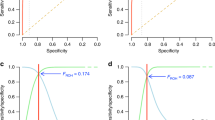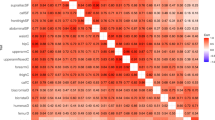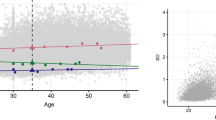Abstract
OBJECTIVE: To determine the extent of the spousal resemblance for adiposity and leanness in the Canadian population.
DESIGN: Cross-sectional population survey.
METHODS: The sample comprised parents and offspring from 1341 families (n=4023) of the Canada Fitness Survey. Indicators of adiposity included the body mass index (BMI) and the sum of five skinfolds (SF5). Both offspring and parents were ranked by their BMI and SF5 percentile position in the population using the entire Canada Fitness Survey database (n=15 818).
RESULTS: Pearson correlations indicated significant spousal resemblance for both BMI (r=0.14; P<0.0001) and SF5 (r=0.13; P<0.0001). However, the magnitude of the spousal correlations varied by the adiposity status of the offspring, with spousal correlations tending to be stronger in parents of lean or obese children and lower among parents of ‘average’ children. Bivariate histograms indicated that among lean (≤5th percentile) and obese offspring (≥95th percentile), the parental pairs tended to cluster among the lower and higher percentiles of adiposity, respectively.
CONCLUSIONS: There are spousal similarities in adiposity, particularly among parents of lean or obese offspring in the Canadian population. The degree to which these similarities are due to a loading of spouses with genes predisposing to obesity or a shared household environment cannot be determined from the present study. However, these results are compatible with the notion that genes and mutations predisposing to obesity are more prevalent among obese parents while those for pronounced leanness are more prevalent among lean parents.
This is a preview of subscription content, access via your institution
Access options
Subscribe to this journal
Receive 12 print issues and online access
$259.00 per year
only $21.58 per issue
Buy this article
- Purchase on Springer Link
- Instant access to full article PDF
Prices may be subject to local taxes which are calculated during checkout




Similar content being viewed by others
References
Bouchard C, Pérusse L, Rice T, Rao DC . The genetics of human obesity. In: Bray GA, Bouchard C, James WPT (eds). Handbook of obesity Marcel Dekker: New York 1998 157–190.
Hebebrand J, Wulftange H, Goerg T et al. . Epidemic obesity: are genetic factors involved via increased rates of assortative mating? Int J Obes Relat Metab Disord 2000 24: 345–353.
Fitness Canada Fitness and lifestyle in Canada Government of Canada: Ottawa 1983.
Fitness Canada Standardized test of fitness: operations manual, 2nd edn. Ministry of Fitness and Amateur Sport: Ottawa 1981.
Pérusse L, Leblanc C, Bouchard C . Inter-generation transmission of physical fitness in the Canadian population Can J Sport Sci 1988 13: 8–14.
Katzmarzyk PT, Pérusse L, Rao DC, Bouchard C . Spousal resemblance and risk of 7-year increases in obesity and central adiposity in the Canadian population Obes Res 1999 7: 545–551.
Allison DB, Neale MC, Kezis MI, Alfonso VC, Heshka S, Heymsfield SB . Assortative mating for relative weight: genetic implications Behav Genet 1996 26: 103–111.
Macdonald SM, Reeder BA, Chen Y, Després J-P, Group CHHSR . Obesity in Canada: a descriptive analysis Can Med Assoc J 1997 157(Suppl 1): S3–S9.
Flegal KM, Carroll MD, Kuczmarski RJ, Johnson CL . Overweight and obesity in the United States: prevalence and trends, 1960–1994 lnt J Obes Relat Metab Disord 1998 22: 39–47.
Tremblay MS, Willms JD . Secular trends in the body mass index of Canadian children Can Med Assoc J 2000 163: 1429–1433 (Published Erratum appears in Can Med Assoc J 2001; 164: 970)
Acknowledgements
Special thanks to Cora Craig and her colleagues at the Canadian Fitness and Lifestyle Research Institute for providing the 1981 Canada Fitness Survey database. Johannes Hebebrand is supported by the Deutsche Forschungsgemeinschaft. Claude Bouchard is supported, in part, by the George A Bray Chair in Nutrition.
Author information
Authors and Affiliations
Corresponding author
Rights and permissions
About this article
Cite this article
Katzmarzyk, P., Hebebrand, J. & Bouchard, C. Spousal resemblance in the Canadian population: implications for the obesity epidemic. Int J Obes 26, 241–246 (2002). https://doi.org/10.1038/sj.ijo.0801870
Received:
Accepted:
Published:
Issue Date:
DOI: https://doi.org/10.1038/sj.ijo.0801870
Keywords
This article is cited by
-
Evidence of correlations between human partners based on systematic reviews and meta-analyses of 22 traits and UK Biobank analysis of 133 traits
Nature Human Behaviour (2023)
-
Examining the association between work stress, life stress and obesity among working adult population in Canada: findings from a nationally representative data
Archives of Public Health (2022)
-
Project TEAMS (Talking about Eating, Activity, and Mutual Support): a randomized controlled trial of a theory-based weight loss program for couples
BMC Public Health (2017)
-
Bariatric Surgery Patients and Their Families: Health, Physical Activity, and Social Support
Obesity Surgery (2016)
-
Spousal diabetes as a diabetes risk factor: A systematic review and meta-analysis
BMC Medicine (2014)



